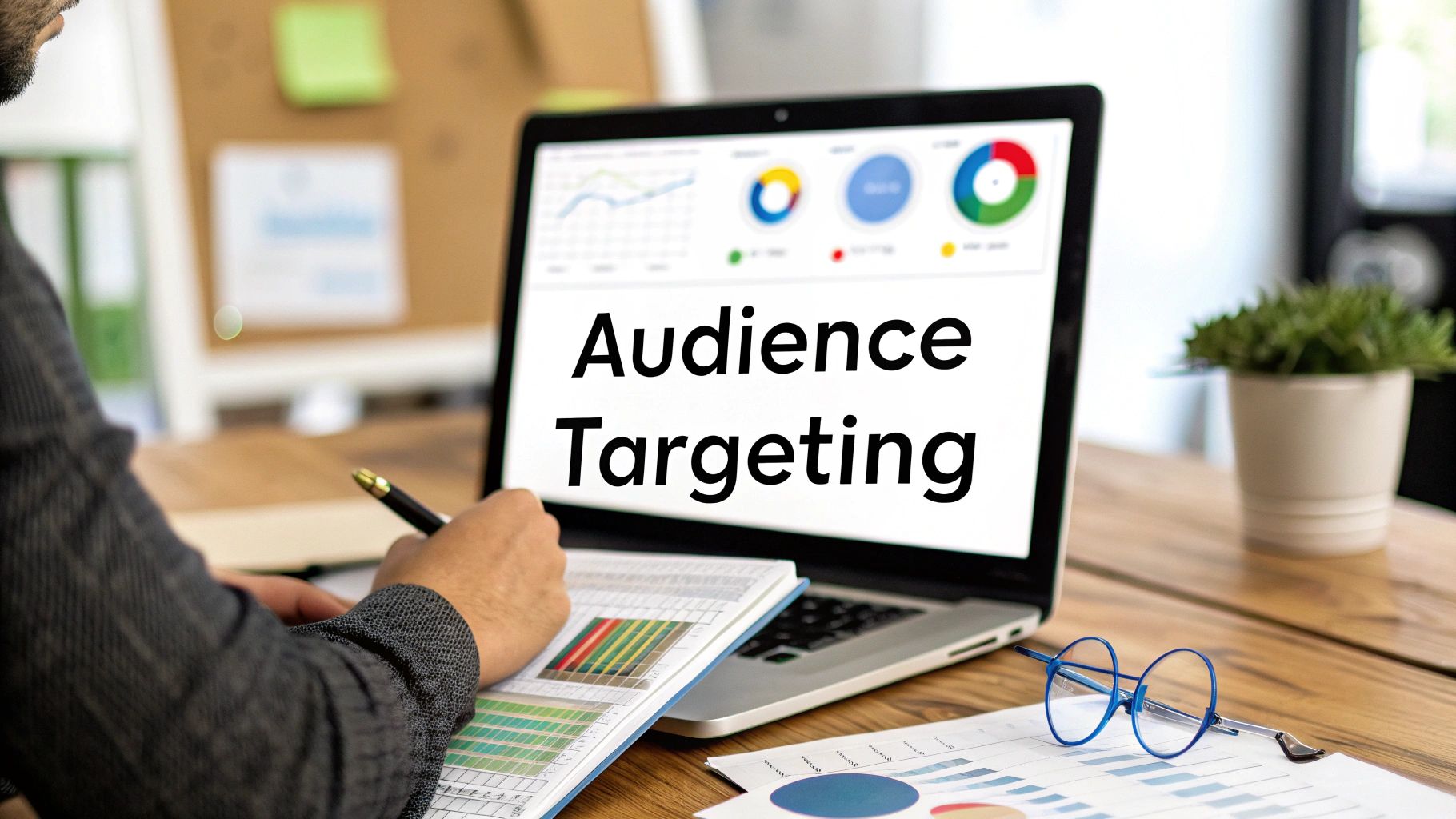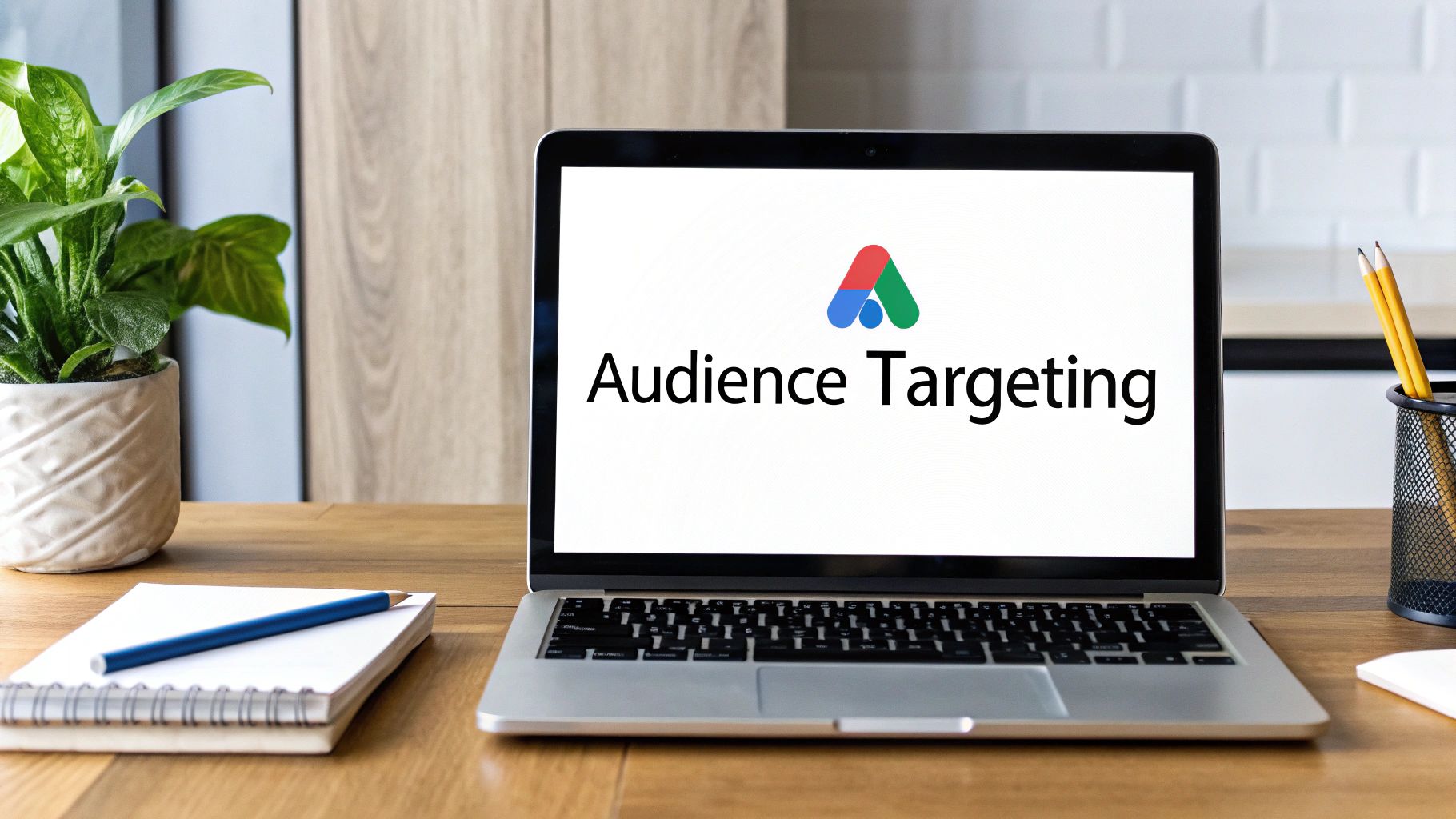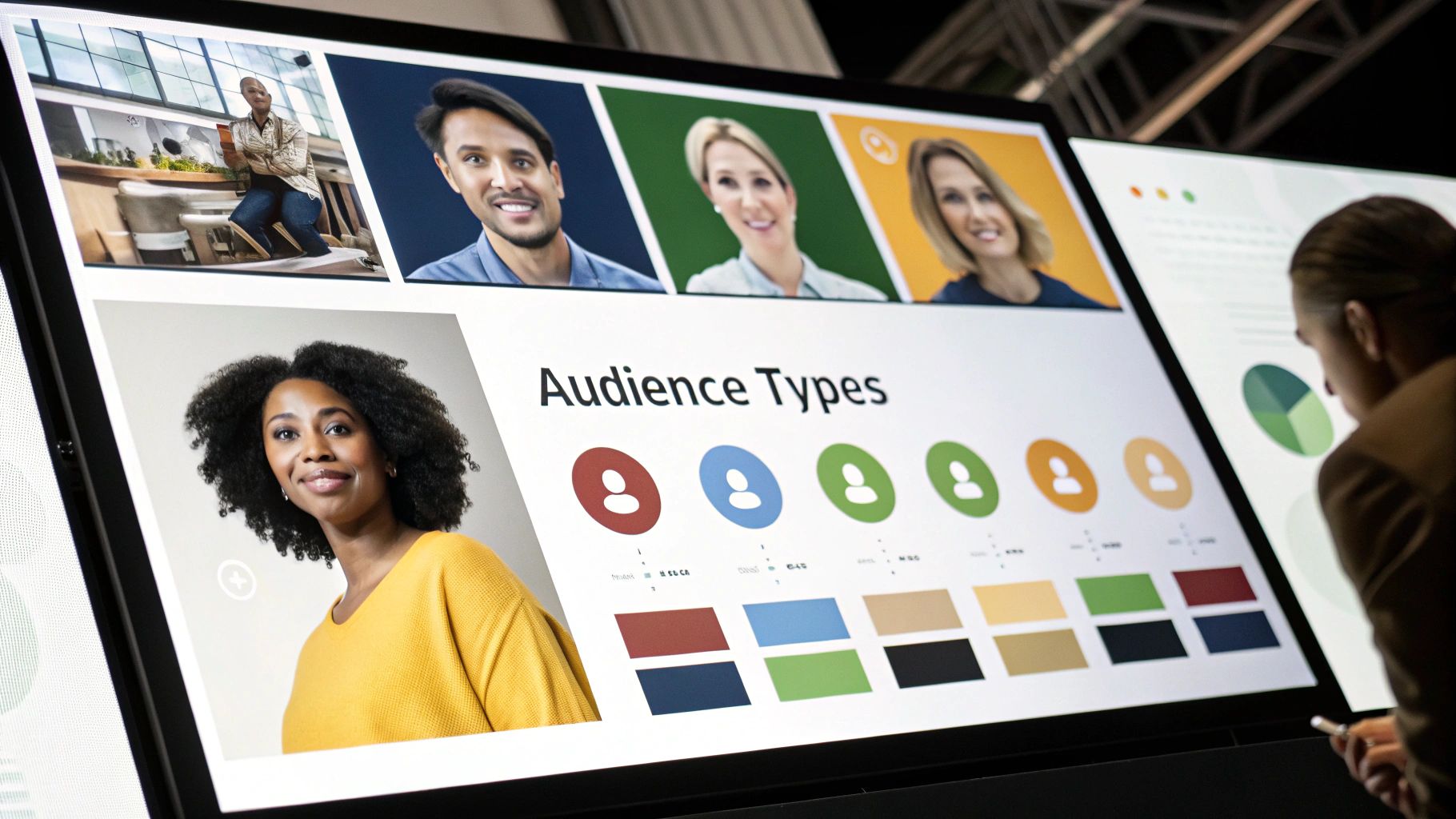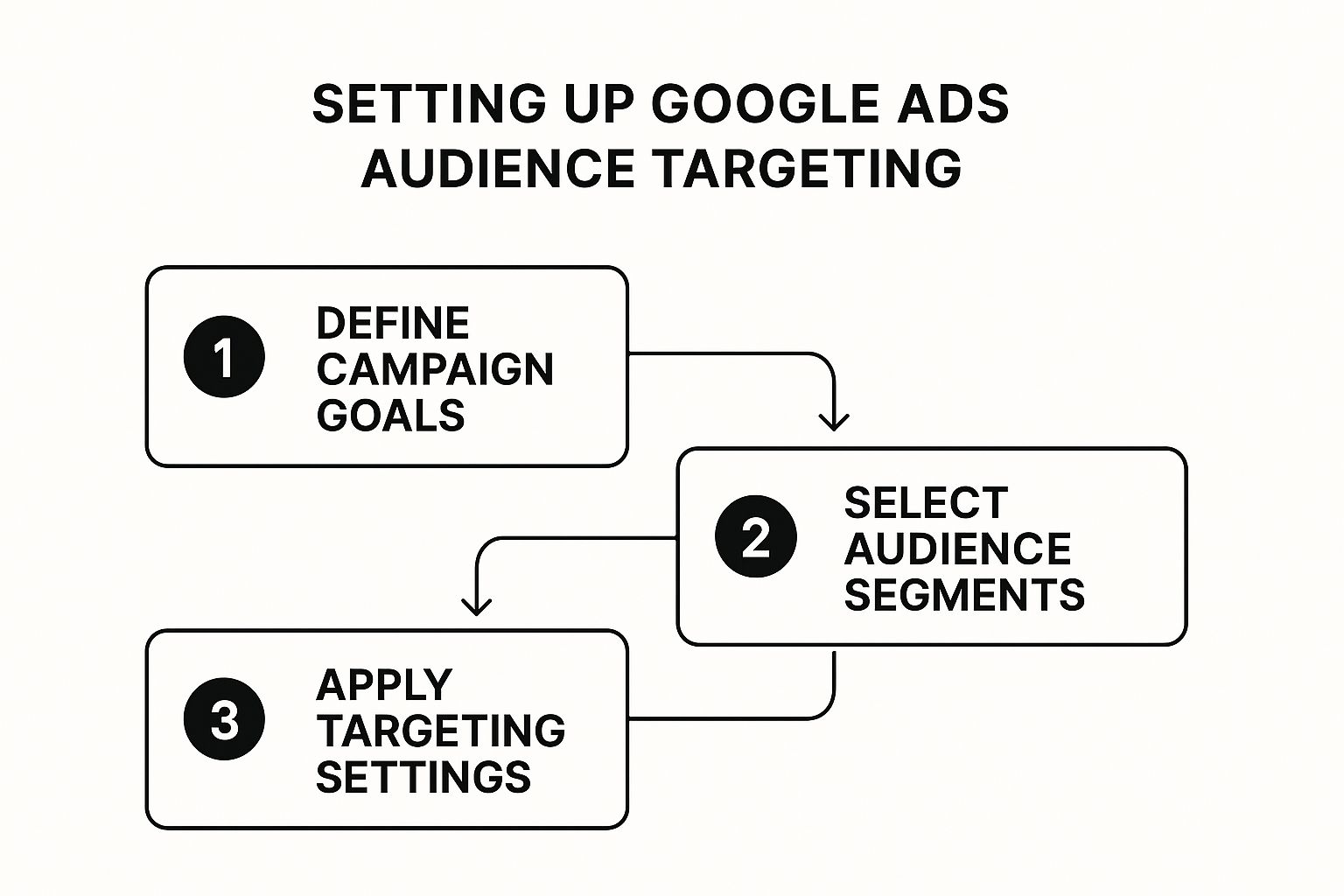July 13, 2025
Google Ads Audience Targeting Guide for Conversions


Let’s get one thing straight: effective Google Ads audience targeting isn't about blasting your message to as many people as possible. It's about getting your ads in front of the right people at the right time. Honestly, this is the single biggest factor that separates campaigns that print money from those that just burn through your budget.
Why Your Ad Spend Is Disappearing

Ever feel like you're just shoveling cash into a bonfire with your Google Ads account? You've spent hours polishing your ad copy, your offer is a no-brainer, but the results are just... meh.
Let's be real. The most common culprit isn't what you’re saying; it’s who you’re saying it to.
Running ads with broad, undefined targeting is a classic rookie mistake. It’s like putting up a billboard for a high-end steakhouse in a town full of vegans. Sure, you’ll get some eyeballs and maybe a few accidental clicks, but you won't sell any steaks. This is where getting laser-focused with your Google Ads audience targeting completely changes the game.
From Spray-and-Pray to Surgical Strikes
The goal isn't to reach the most people. The goal is to reach the most relevant people. This is a fundamental mindset shift. Stop casting a massive, expensive net and hoping for the best. Instead, pick up a finely-tuned fishing rod to catch exactly the fish you’re after.
When your ads connect with people who are actually looking for what you sell, everything clicks into place. Your Click-Through Rate (CTR) shoots up, your Quality Score improves, and most importantly, your conversion rate climbs. This isn't just about saving a few bucks; it's about making every dollar you spend work smarter and harder. For a deeper dive into campaign improvements, this Google Ads optimization checklist is a fantastic resource.
Key Takeaway: Stop paying for clicks from people who will never buy. Smart audience targeting puts your message in front of high-intent users, which is the most direct path to boosting your ROI.
Your Starting Point: The Core Audience Types
Google gives you a powerful toolkit right out of the box. Think of these core audience types as your primary building blocks for defining who sees your ads.
To help you get started, here's a quick rundown of the main audience categories and when to use them.
Quick Guide to Google Ads Audience Types
These audience types are your foundation for building a highly targeted and profitable campaign.
Of course, getting the right person to click is only half the battle. If your landing page isn't up to snuff, they'll just leave. That's why understanding strategies to lower your website's bounce rate is a crucial next step to ensure that ad spend turns into actual business.
Building Your Foundation with Core Audience Types
Jumping into Google Ads audience targeting can feel like a lot to take in, but it really boils down to getting a handle on a few foundational pieces first. Think of Affinity, In-Market, and Demographic audiences as the essential building blocks for pretty much any solid campaign. Nail these from the get-go, and you've got a strategy that can actually work.
Before you even touch a single setting in Google Ads, the first real step is knowing exactly how to find your target audience. This is the bedrock of everything else you'll do. Once you have a crystal-clear picture of who you're trying to talk to, you can pick the right tools for the job.
The scale here is just staggering. Google commands an 81.95% slice of the global search engine market. In some places, like the UK, that number climbs to a whopping 93.51%. This reach means Google Ads can connect you with the 63% of internet users who've clicked on one of its ads—a massive pool of potential customers. If you're curious, you can dig into more key Google Ads statistics to see the full picture.
Using Affinity Audiences for Brand Buzz
I like to think of Affinity audiences as casting a wide, but smart, net. These are big groups of people Google has identified as having long-term passions or interests, like "Foodies," "Movie Lovers," or "Thrill Seekers."
You wouldn't typically use Affinity audiences to chase down immediate sales. That's not what they're for. Instead, they are your best friend for top-of-funnel campaigns where the main goal is just getting your name out there and building brand awareness. You’re introducing your brand to people who are generally interested in your space, even if they aren't looking to buy right this second.
Here’s how it plays out in the real world:Let's say you're launching a new line of plant-based protein powders. You could target the "Health & Fitness Buffs" and "Green Living Enthusiasts" Affinity audiences. Your ads wouldn't be screaming "Buy Now!" Instead, you might offer a free recipe guide or create content about the sustainable sourcing of your ingredients. It's about building that initial familiarity and trust.
Capturing Sales with In-Market Audiences
Alright, let's shift gears to driving actual sales. In-Market audiences are your secret weapon for finding people who are actively researching and getting very close to making a purchase. Google flags these users based on their recent search behavior, the sites they're visiting, and the content they're consuming.
These are your hot leads. They're in comparison mode, reading reviews, and hunting for the best option. When you target an In-Market audience, your message needs to be direct, compelling, and built to convert.
Pro Tip: In-Market audiences are absolute gold for Search and Shopping campaigns. You're literally meeting someone at the exact moment they're showing they want to buy. You can't afford to waste that opportunity with a weak offer.
For instance, an online store selling high-end gaming laptops would zero in on the "Computers & Peripherals > Laptops" In-Market segment. Their ads would shout about specific features, competitive prices, or maybe a limited-time offer to give that person the final nudge they need to click "Add to Cart."
Refining Your Reach with Demographics
Finally, we have demographics. These are the straightforward but absolutely critical layers you use to sharpen your targeting. This includes:
- Age: Focusing on the specific age ranges that match your ideal customer.
- Gender: Choosing to show ads to men, women, or everyone, depending on your product.
- Parental Status: Reaching parents of toddlers, teenagers, or even expectant parents.
- Household Income: Targeting users in certain income brackets (just note this is only available in some countries).
You almost never use demographic targeting all by itself. Its real power is unleashed when you layer it on top of an Affinity or In-Market audience. It’s how you add that extra dose of precision.
Think back to that local bakery. They could target by "Parents of Toddlers (1-3 years)" and layer that with location targeting for their city. Suddenly, they're showing ads for custom birthday cakes right when those parents are most likely to be planning a party. By mixing and matching these core audience types, you start to build a truly effective Google Ads audience targeting strategy that gets you in front of the right people, at the right time.
Unlocking Advanced Targeting with Custom Audiences

If core audiences are the building blocks, then custom audiences are where you truly become an architect. This is how you gain a serious competitive edge, moving beyond Google's pre-made categories into genuinely surgical Google Ads audience targeting. It’s all about creating your own audiences from scratch, using the exact signals that actually matter to your business.
Think you're ready to stop guessing and start targeting with pinpoint precision? Good. Let's get into it.
Target People Based On What They Search For
Imagine showing your ads to people based on the exact keywords they've recently typed into Google. That’s the magic of custom segments built on search activity. We're not talking about bidding on keywords for your search campaigns here. This is about building an audience for your Display, Discovery, or YouTube ads, full of people who have already shown clear intent through their search history.
This is an absolute game-changer. You can get incredibly creative and strategic with this.
A classic, and highly effective, move is to target users who have recently searched for your main competitors. If someone is Googling "Competitor X pricing" or "Competitor Y reviews," you know for a fact they're in the market for what you sell. You can then swoop in with a compelling ad on a news site or YouTube video they visit later, showing them exactly why your solution is the better choice.
Turn Website Visitors into Your Next Customers
Another seriously powerful custom audience is one built from people who have visited specific types of websites. Just think about the blogs, forums, or news sites your ideal customer hangs out on. By plugging these URLs into a custom segment, you're essentially telling Google, "Go find me more people who look just like the ones who visit these sites."
For example, if you sell high-end kitchen knives, you could create an audience of people who frequent popular cooking blogs, recipe sites, or even the websites of specific celebrity chefs. You're not advertising on those sites directly; you're targeting the type of person who goes there, wherever they happen to be across the Google Display Network.
My Two Cents: Custom audiences based on URLs or search terms let you get in front of high-intent users before they even know you exist. You’re tapping into their existing behavior to identify them as prime prospects.
The Fine Art of Smart Remarketing
Alright, let's talk about remarketing (or what Google now calls "Your data" audiences). This is your golden opportunity to re-engage people who have already checked out your site. But please, don't be that brand that just follows every single visitor around for 30 days with the same generic ad. That’s how you annoy people, not convert them.
Smart remarketing is all about segmentation. You have to treat different visitors differently based on what they actually did on your site.
Here’s how I break down remarketing lists for much better results:
- Cart Abandoners: These are your hottest leads, period. They were this close to buying. Hit them with a targeted ad showing the exact product they left behind. A small nudge like a discount or a free shipping offer can often seal the deal.
- Blog Readers: Someone who only skimmed a blog post is worlds away from a cart abandoner. Instead of a hard sell, serve them ads for related content, a webinar, or a downloadable guide. Nurture them down the funnel.
- Past Purchasers: Don't neglect your existing customers! Create remarketing lists to upsell them on complementary products or let them know when new stuff arrives. They already trust you.
- High-Value Page Visitors: Did someone visit your pricing page or a key product page multiple times? That’s a massive signal of interest. Create a special audience just for these users and show them ads that tackle common questions or highlight key benefits.
Beyond these custom segments, using lookalike audiences is a fantastic way to expand your reach. Google takes your source audience (like "Past Purchasers") and finds new users across the web who share similar characteristics.
Getting Pinpoint Accurate with Dynamic Remarketing
Dynamic remarketing takes things to a whole new level. If you run an e-commerce store, this is an absolute must-have. It automatically shows your past visitors ads that feature the specific products they viewed, added to their cart, or even previously purchased.
So, instead of a generic brand ad, a user who looked at a specific pair of red running shoes will see an ad for those exact red shoes. It’s personal, it’s hyper-relevant, and it just plain works. The setup requires a product feed and some extra tagging on your site, but the lift in conversion rates is almost always worth the initial effort.
When you combine sharp custom audiences with smart exclusions, you create a truly efficient advertising machine.
Layering Audiences for Hyper-Precise Targeting
Alright, so we’ve walked through the individual tools in your Google Ads audience targeting toolkit. Now for the really fun part—making them work together. Honestly, this is where the magic happens. Using a single audience type is fine, but when you start layering them, you can achieve some truly incredible results.
Think of it as building a profile of your perfect customer, piece by piece. You might start with a broad interest, then sharpen the focus with their recent search behavior, and cap it off with a major life event. You're combining different signals to create a super-specific, high-intent audience that most of your competitors are probably overlooking entirely.
The Power of the Stack
Let's say you run a high-end HVAC company. You don't just want clicks; you need to find homeowners who are actually ready to invest in a premium system. Instead of casting a wide net, you can build a powerful audience stack.
Here's how I'd approach it:
- Layer 1 (The Foundation): I'd start with an In-Market audience for "HVAC Services" or maybe "Home Renovation." This gives us a solid pool of people who are already kicking the tires.
- Layer 2 (The Intent Signal): Next, I’d layer on a Custom Audience targeting people who have recently Googled specific, high-intent terms. Think "high-efficiency furnace cost," "smart thermostat installation," or "best AC unit for large homes."
- Layer 3 (The Life Moment): To really zero in, I'd add a Life Event audience for "Recently Moved" or "Recently Purchased a Home." New homeowners are an absolute goldmine for HVAC upgrades.
See what we did there? By combining these three layers, you're not just targeting "people interested in HVAC." You're specifically going after new homeowners who are actively researching high-efficiency systems right now. The quality of these leads will be worlds apart from any single-audience campaign.
A Real-World Example of Layered Success
And this isn't just theory. I’ve seen this work wonders. A high-end HVAC client of ours did something very similar. They combined in-market audiences (people looking for 'new AC installation') with custom intent audiences (those searching for 'energy efficient home upgrades'). Then, for that extra layer of precision, they targeted new homeowners.
The results were staggering. In just three months, they saw a 42% increase in their average ticket size and their customer acquisition cost dropped by 31%. It’s a powerful strategy. You can actually dig into more of their Google Ads strategies and findings to see the full picture.
This process flow chart really breaks down the basic steps for getting any effective audience targeting strategy off the ground.

The big takeaway is that great targeting isn't just about picking an audience from a list. It's a structured process that starts with knowing your goals and ends with putting your strategy into action deliberately.
The Critical Difference Between Targeting and Observation
This next part is crucial, so pay close attention. When you add audiences to your campaigns (especially on Search), Google Ads gives you two settings: "Targeting" and "Observation." If you don't understand the difference, you're going to waste a lot of money.
Targeting: Just like it sounds, this setting restricts your ad delivery. Your ads will only show to people who match your other criteria (like keywords) and belong to the audience you've selected. It narrows your reach. You use this when you're dead certain this is the exact group you want, which is common for Display and YouTube campaigns.
Observation: This setting is completely different. It doesn't restrict your reach at all. Your ads show normally, but Google quietly collects data in the background on how people in your selected audiences perform. This lets you see if, for example, your "In-Market for Used Cars" audience converts better than the general public. If they do, you can apply a bid adjustment to bid more aggressively on just that group.
Pro Tip: For any Search campaign, always start with "Observation." It's a pure data-gathering play. It lets you test your theories and see which audiences are actually valuable without accidentally strangling your campaign's reach right out of the gate.
By starting in Observation mode, you can test your layered audience theories without any risk. Add that stacked audience of new homeowners researching HVAC systems and just watch the data roll in. If you see they have a much higher conversion rate, then you can increase your bids for them or even spin up a whole new campaign using the "Targeting" setting to go after them with everything you've got. This approach lets you make smart, data-driven decisions that turn insights into real profit.
Letting AI Do the Heavy Lifting for You

Manually building and layering audiences is powerful, but let’s be honest—it takes a ton of time and testing. What if you could tap into Google's own machine learning to uncover new customers you didn't even know existed? It's time to put AI to work for your Google Ads audience targeting.
These tools aren't just about automation; they're about discovery. Google's AI can analyze millions of user signals in real-time, spotting patterns and opportunities a human analyst might completely miss. This approach can seriously expand your reach beyond the audiences you’ve so carefully built.
The evolution in Google Ads audience targeting is obvious, with a major shift toward AI. This has paved the way for smart audience options that zero in on user behavior and lookalike audiences that find new users who mirror your best customers. If you want to dive deeper into where the industry is headed, check out these insights on how AI is shaping Google Ads benchmarks.
Find New Customers with Similar Audiences
Similar Audiences, or lookalikes, are one of the most straightforward ways to let AI expand your reach. The idea is simple but crazy effective: you give Google a "seed" audience, and its algorithm goes out to find new people who share similar online behaviors and traits.
Your seed audience can be almost any high-value list you have. I've seen this work wonders with:
- Your best customers (from a customer list upload)
- People who have recently made a purchase
- Users who filled out a specific form
- Your most engaged remarketing list
Think of it like this: if you know people who buy your premium running shoes also tend to read certain running blogs and follow specific athletes on YouTube, Google's AI can find thousands of other people with that same digital footprint. It’s a fantastic way to find top-of-funnel prospects who are very likely to be interested in your brand.
Going All-In with Performance Max Campaigns
If Similar Audiences are like letting AI co-pilot, then Performance Max (PMax) campaigns are like handing over the keys and letting it drive. PMax is a goal-based campaign type that uses machine learning to find converting customers across Google's entire inventory—Search, Display, YouTube, Discover, Gmail, and Maps.
You don't pick individual audience targets in the traditional sense. Instead, you provide "audience signals" to give the AI a starting point. These signals are your best guess at who your ideal customer is, including your own data (like remarketing lists and customer match) and custom segments.
The AI takes these signals and then hunts for pockets of converting users wherever it can, often well outside your initial suggestions. It’s a bit of a "black box," which can be scary for advertisers who, like me, love to be in control.
My Honest Take: PMax can be incredibly powerful, especially for e-commerce, but you have to feed it the right data. Strong conversion tracking is non-negotiable. Without accurate data, the AI is essentially flying blind and will optimize for the wrong actions, torching your budget.
When to Trust the AI and When to Take Control
So, should you go all-in on AI or stick to manual control? Honestly, the best answer is usually "both." It's not about choosing one over the other, but knowing when to use each tool.
Lean on AI-powered tools like PMax when:
- You have a strong conversion history—I’m talking at least 50+ conversions in the last 30 days.
- Your main goal is to scale your campaigns and find new avenues for growth.
- You're an e-commerce brand with a large, well-structured product feed.
Stick with manual audience controls when:
- You're in a highly regulated industry (like finance or healthcare) with strict targeting rules.
- Your campaign budget is small, and you need to watch every dollar.
- You're just starting out and don't have enough conversion data to properly guide the machine learning.
A smart strategy I often recommend is to run a PMax campaign alongside your standard Search and Display campaigns. Let the AI do its thing while you continue to refine your manually targeted efforts. This way, you get the scale of machine learning without completely giving up the granular control and insights from traditional campaigns.
Common Questions About Google Ads Targeting
Got questions? I've got answers. Even with a killer strategy, you're bound to run into questions when you're in the trenches of Google Ads audience targeting. Let's tackle some of the most frequent ones I hear to help you sharpen your approach and get past those common roadblocks.
How Long Does It Take for Audience Targeting to Work?
This is the big one. Everyone wants to know when the magic happens. While you might see some clicks and impressions trickle in within a few days, you've got to play the long game.
Honestly, it usually takes Google's algorithm a solid 2-4 weeks to really learn and get its bearings with a new audience. The system needs to collect enough data to figure out who’s actually biting. If you jump in and make big changes too soon, you’re just hitting the reset button on that learning phase. So, be patient.
Can I Use Audience Targeting on the Search Network?
Yes, and you absolutely should! I'm always surprised how many advertisers miss out on this. For Search campaigns, you'll want to apply your audiences using the "Observation" setting.
This setting doesn't actually limit who sees your ads. Instead, it acts like a layer of intel, letting you see how specific audiences (like people "in-market" for your products) perform for your keywords. Once you have that data, you can apply bid adjustments. For example, if you see an audience converting well, you can bump up your bids by 20% just for them to get more of that high-quality traffic.
Key Takeaway: Using audiences in "Observation" mode on Search is a totally risk-free way to gather performance data. It lets you make much smarter bidding decisions without cutting off your potential reach.
Should I Worry if My Audience Size Is Too Small?
It’s a balancing act, for sure. A super-niche audience can be a goldmine, but if it's tiny, your ads might not even get shown.
For Display and YouTube, Google's rule of thumb is to have at least 1,000 active users in an audience for consistent ad delivery. If you've layered a bunch of targeting options together and your estimated reach is looking grim, try peeling back the single most restrictive layer and see what happens. It's all about testing and finding that sweet spot between precision and scale.
What Is the Difference Between Targeting and Observation?
Getting this right is crucial for managing your budget and reach. The setting you pick fundamentally changes how Google applies an audience to your campaign.
Targeting: This is restrictive. It tells Google to show your ads only to the people in your selected audience. Think of it as putting up walls. It's great for Display, Video, or very specific Search campaigns where you're dead certain you only want to reach a particular group.
Observation: This is inclusive. It doesn't restrict who sees your ads. Your ads still show based on your keywords or other targeting, but you get to "observe" how specific audiences within that broader group perform. This is almost always the right choice for Search campaigns.
Ultimately, great targeting is just one part of the equation. You need rock-solid conversion tracking to actually know what’s working. For a full walkthrough, you can learn more about setting up Google Ads conversion tracking to make sure your data is telling you the truth. That's how you connect your audience strategy to real business results.


.svg)